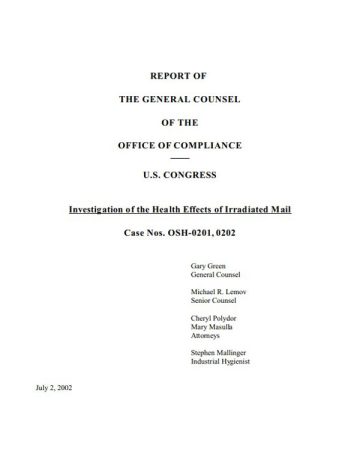Executive Summary
The irradiation of Congressional mail beginning in November 2001 followed the detection of anthrax spores in 16 Congressional offices. It represented the first use of the irradiation process to eradicate anthrax spores from the mail delivery system. Beginning in January 2002, when the United States Postal Service began delivering irradiated mail to Congressional offices, the Office of Compliance became aware of numerous employee complaints of adverse health symptoms apparently caused by contact with irradiated mail, including headaches, nausea, nose bleeds, rashes, eye and skin irritation and similar symptoms.
In February 2002, Senator Charles Grassley and two House of Representatives employees filed Requests for Inspection with the General Counsel of the Office of Compliance, seeking an investigation of the possible adverse health effects of irradiated mail, and the related decontamination of the Hart Senate Office Building. The General Counsel initiated an investigation based upon receipt of these requests. The General Counsel’s investigation consisted of review of a redacted version of a report prepared for the House/Senate Legislative Mail Task Force by the National Institutes of Occupational Safety and Health (“NIOSH”); consultation with Dr. Laura Welch, Chief of the Section of Occupational and Environmental Medicine, Washington Hospital Center; Dr. Clifford Mitchell, Director, Occupational Medicine Program, Johns Hopkins University; the staff of the Occupational Safety and Health Administration (“OSHA”) and the OSHA Salt Lake Technical Center. Additionally, we obtained information and assistance from the Library of Congress Health Services Office, the Attending Physician of the Capitol and officials of the U.S. Postal Service.
Our inspection team also conducted its own sampling of the chemical by-products of irradiated mail, both on Capitol Hill and at the U.S. Postal Service facilities where mail is irradiated and prepared for delivery to Congressional offices. Finally, the General Counsel conducted a survey of potentially affected employees, including review of two hundred fifteen (215) Contact Sheets provided to us by affected employees; a telephone survey; a re-survey reaching a majority of those employees, providing us with updated information; and evaluation of eighty-one (81) detailed medical questionnaires completed by employees at our request.
